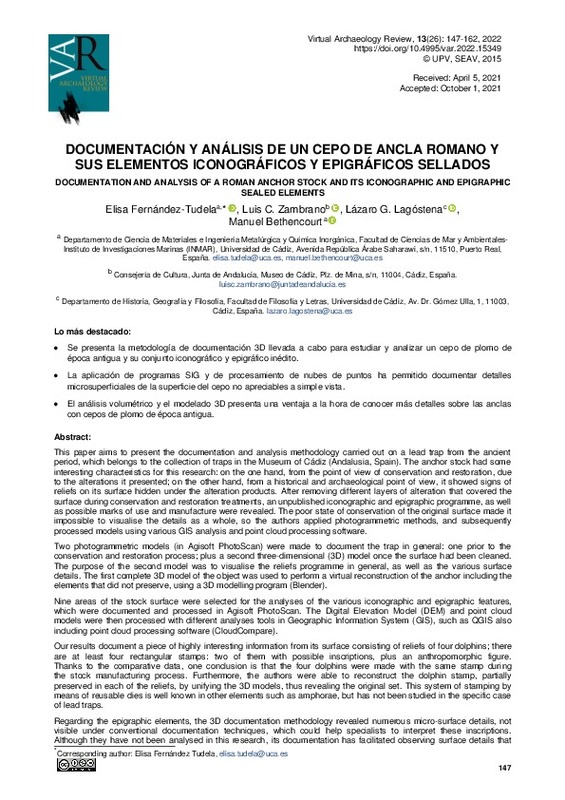Andreu, J., & Serrano, P. (2019). Contributions of the digital photogrammetry and 3D modelling of Roman inscriptions to the reading of damaged tituli: An example from the Hispania Tarraconensis (Castiliscar, Saragossa). Digital Applications in Archaeology and Cultural Heritage, 12, e00091. https://doi.org/10.1016/j.daach.2019.e00091
Bennison-Chapman, L. E., & Hager, L. D. (2018). Tracking the division of labour through handprints: Applying Reflectance Transformation Imaging (RTI) to clay 'tokens' in Neolithic West Asia. Journal of Archaeological Science, 99, 112-123. https://doi.org/10.1016/j.jas.2018.09.004
Bravo, J. (1976a). Evolución y técnica en la construcción de anclas antiguas. En Ancorae Anticuae I. Ceuta: Sala Municipal de Arqueología.
[+]
Andreu, J., & Serrano, P. (2019). Contributions of the digital photogrammetry and 3D modelling of Roman inscriptions to the reading of damaged tituli: An example from the Hispania Tarraconensis (Castiliscar, Saragossa). Digital Applications in Archaeology and Cultural Heritage, 12, e00091. https://doi.org/10.1016/j.daach.2019.e00091
Bennison-Chapman, L. E., & Hager, L. D. (2018). Tracking the division of labour through handprints: Applying Reflectance Transformation Imaging (RTI) to clay 'tokens' in Neolithic West Asia. Journal of Archaeological Science, 99, 112-123. https://doi.org/10.1016/j.jas.2018.09.004
Bravo, J. (1976a). Evolución y técnica en la construcción de anclas antiguas. En Ancorae Anticuae I. Ceuta: Sala Municipal de Arqueología.
Bravo, J. (1976b). Cepos de anclas con relieves recuperados en el Mediterráneo Occidental. En Ancorae Anticuae I. Ceuta: Sala Municipal de Arqueología.
Cano, A. I. (2003). Aproximación al estudio de la minería del plomo en Extremadura y sus usos en época romana. Bolskan: Revista de arqueología del Instituto de Estudios Altoaragoneses, (20), 119-130.
Carrero-Pazos, M., & Espinosa-Espinosa, D. (2018). Tailoring 3D modelling techniques for epigraphic texts restitution. Case studies in deteriorated Roman inscriptions. Digital Applications in Archaeology and Cultural Heritage, 10, e00079. https://doi.org/10.1016/j.daach.2018.e00079
Carrero-Pazos, M., Vilas-Estévez, B., & Vázquez Martínez, A. (2018). Digital imaging techniques for recording and analysing prehistoric rock art panels in Galicia (NW Iberia). Digital Applications in Archaeology and Cultural Heritage, 8, 35-45. https://doi.org/10.1016/j.daach.2017.11.003
Cerrillo-Cuenca, E., Bueno-Ramírez, P., & de Balbín-Behrmann, R. (2019). "3DMeshTracings": A protocol for the digital recording of prehistoric art. Its application at Almendres cromlech (Évora, Portugal). Journal of Archaeological Science: Reports, 25, 171-183. https://doi.org/10.1016/j.jasrep.2019.03.010
Chatonnet, F. B. (2007). Première ancre à inscription néopunique. Orientalia, 76(1), 24-29.
Ferrer i Jané, J., & Sinner, A. G. (2019). Baitolo, una doble inscripción ibérica en un cepo de ancla de plomo del siglo I a.C. Palaeohispanica. Revista sobre lenguas y culturas de la Hispania Antigua, (19), 147-167. https://doi.org/10.36707/palaeohispanica.v0i19.207
Fiorini, A. (2018). Il metodo fotografico RTI (reflectance transformation imaging) per la documentazione delle superfici archeologiche. L'applicazione ai materiali di età protostorica. Archeologia e Calcolatori, 29, 241-258. https://doi.org/10.19282/ac.29.2018.20
García, C., & López, M. D. (1980). Elementos de anclas antiguas del Museo de Cádiz. Boletín del Museo de Cádiz,2, Cádiz, 67-72.
Goldman, Y., Linn, R., Shamir, O., & Weinstein-Evron, M. (2018). Micro-RTI as a novel technology for the investigation and documentation of archaeological textiles. Journal of Archaeological Science: Reports, 19, 1-10. https://doi.org/10.1016/j.jasrep.2018.02.013
Hadas, G., Liphschitz, N., & Bonani, G. (2005). Two ancient wooden anchors from Ein Gedi, on the Dead Sea, Israel. International Journal of Nautical Archaeology, 34(2), 299-307. https://doi.org/10.1111/j.1095-9270.2005.00061.x
Haldane, D. (1984). The wooden anchor. Texas: Texas A&M University.
Hristov, I. (2013). Antique stone anchors, stone and lead anchor stocks from the collection of The National Museum of History. End of 2nd ML B.C. - 3rd century A.D. Sofia: UNICART.
Kapitän, G. (1984). Ancient anchors-technology and classification. The International Journal of Nautical Archaeology, 13(1), 33-44. https://doi.org/10.1111/j.1095-9270.1984.tb01175.x
Kuleff, I., Djingova, R., Alexandrova, A., Vakova, V., & Amov, B. (1995). INAA, AAS, and lead isotope analysis of ancient lead anchors from the black sea. Journal of Radioanalytical and Nuclear Chemistry, 196(1), 65-76. https://doi.org/10.1007/BF02036290
Lech, P., Matera, M., & Zakrzewski, P. (2021). Using reflectance transformation imaging (RTI) to document ancient amphora stamps from Tanais, Russia. Reflections on first approach to their digitalisation. Journal of Archaeological Science: Reports, 36, 102839. https://doi.org/10.1016/j.jasrep.2021.102839
López-Martínez, T., García-Bueno, A., & Medina-Flórez, V. J. (2018). New methodology for the assessment of cleaning treatments. Applications of photogrammetry for restoration. Journal of Cultural Heritage, 30, 117-123. https://doi.org/10.1016/j.culher.2017.09.019
Martínez, A. (2011). Iconografía sagrada fenicio-púnica en las monedas de Hispania siglos III al I a. C. El Futuro del Pasado : Revista Electrónica de Historia, 2, 579-600. https://doi.org/10.14201/fdp.24666
Nicolae, C., Nocerino, E., Menna, F., & Remondino, F. (2014). Photogrammetry applied to problematic artefacts. The International Archives of the Photogrammetry, Remote Sensing and Spatial Information Sciences, XL-5, 451-456. https://doi.org/10.5194/isprsarchives-XL-5-451-2014
Perea, S. (2004). Zeus Kásios Sózon y Afrodita Sózousa, divinidades protectoras de la navegación. A propósito de dos cepos de anclas romanas procedentes del Cabo de Palos. Mastia: Revista del Museo Arqueológico Municipal de Cartagena, (3), 95-111.
Perrone, M. (1979). Ancorae antiquae: Per una cronologia preliminare delle ancore del Mediterraneo. Roma: L'Erma di Bretschneider.
Poigt, T. (2015). Volume measurement by photogrammetry. Applications for the weighing metrology studies. En I International Conference on Metrology for Archaeology, 1, (pp.197-202), Benevento, Italy.
Ramon , J. (1995). Las ánforas fenicio-púnicas del Mediterráneo central y occidental. Barcelona: Universitat de Barcelona.
Rosen, B., & Galili, E. (2007). Lead use on Roman ships and its environmental effects. International Journal of Nautical Archaeology, 36(2), 300-307. https://doi.org/10.1111/j.1095-9270.2007.00145.x
Solem, D.-Ø. E., & Nau, E. (2020). Two new ways of documenting miniature incisions using a combination of image-based modelling and reflectance transformation imaging. Remote Sensing, 12(10), 1626. https://doi.org/10.3390/rs12101626
Torregrosa-Fuentes, D., Spairani-Barrio, Y., Huesca-Tortosa, J. A., Cuevas-González, J., & Torregrosa-Fuentes, A. J. (2018). Application of automated photogrammetry and lighting techniques with GIS tools for visualisation and analysis of a slab with anthropomorphous reliefs. Virtual Archaeology Review, 9(19), 114-124. https://doi.org/10.4995/var.2018.9531
Valente, R., & Barazzetti, L. (2020). Methods for ancient wall graffiti documentation: overview and applications. Journal of Archaeological Science: Reports, 34, 102616. https://doi.org/10.1016/j.jasrep.2020.102616
Zotkina, L. V., & Kovalev, V. S. (2019). Lithic or metal tools: Techno-traceological and 3D analysis of rock art. Digital Applications in Archaeology and Cultural Heritage, 13, e00099. https://doi.org/10.1016/j.daach.2019.e00099
[-]









